When it comes to grooming, cats like to do things on their own terms—and that can make trimming their nails a daunting prospect. But it doesn’t have to be! In fact, most cats can learn to tolerate nail clipping with a bit of practice and plenty of treats. So, are you ready to learn how to cut cat nails? I was a groomer for 12 years, and I’m here to give you step-by-step tips for how to trim cat nails to help you and your kitty through the process.
In This Guide
How Often Should You Cut Your Cat’s Nails?
In general, indoor cats need their nails cut every couple of weeks. Kittens’ nails grow more quickly and may need to be trimmed every week, while some older cats will only need trims about once a month. Outdoor felines need sharper nails for defending themselves, so they may only need cat nail clipping a few times a year.
When Are a Cat’s Nails Too Long?
When you notice any of these signs, that’s a good indication that it’s time to get out the clippers.
- They don’t retract all the way
- They are very curved
- They are incredibly sharp
What Happens If My Cat’s Nails Get Too Long?
Overgrown claws might not sound like a big deal, but letting a cat’s nails grow too long can cause some serious damage, including:
- Injury to your cat’s paw pads from nails that have curled and grown into them
- Changes in your cat’s gait, which can lead to long-term joint issues
- Getting stuck in carpets or your cat’s collar, which can cause discomfort or injury for your cat
- Damage to your furniture
- Risk of injury to yourself from your cat’s scratches
Let's Get Trimming: A Step-by-Step Guide
1 Gather Your Supplies

Make sure you have everything you’ll need within reach before you start. You don’t want to have to interrupt your nail trimming session—especially if your cat isn’t a huge fan of nail trims.
What You’ll Need
Make sure you have these items for cat nail clipping:
- Nail trimmer or grinder
- Cat treats
- Styptic powder (recommended), flour or cornstarch
- Towel to wrap your cat in (optional)
- A helper (optional, but handy)
- Calm nerves and plenty of patience!
Types of Grinders and Clippers
There are a variety of different types of nail clippers and grinders available for cutting cat nails:
- Scissors-style nail clippers, like the these Frisco clippers, look like small scissors with divots for the nail. As a groomer, these are my preferred type of nail clippers for cats.
- Guillotine-style nail clippers, like the Resco Original Cat Nail Clippers have a hole you poke the nail through before sliding the blade across to cut it. These type of clippers stay sharp longer than other clippers, but they can be tricky to use on cats because inserting the cat’s nail into a hole adds a layer of difficulty to the process.
- Pliers-style nail clippers, such as the H&H Pets Dog & Cat Nail Clipper, have a spring, giving them more strength if your kitty has extra thick nails.
- Nail grinders, like the Dremel 7300-PT Nail Grinder, can help file your cat’s nails smooth—but their mechanical hum is stressful for some cats, which can make the process of trimming less enjoyable for you both. If you're a first-timer, or if your cat is extra-sensitive, we recommend trying the other types of trimmers first.
2 Find a Quiet Spot and a Comfortable Position

Trimming your cat’s nails in a quiet area of your home, away from kids, other pets or startling noises, will help keep your cat calm, making cutting their nails easier. Spraying the pheromone Feliway onto the area or blanket to be used for your kitty’s nail trim 15 minutes ahead of time can help keep your furry friend calm and at ease.
With practice, you will find the best way to hold your cat—one that’s comfortable for both of you. If you’re a beginner, try these positions:
- Seated and holding your cat lengthwise across your lap
- Standing and holding your cat on a flat surface that you don’t mind getting scratched, such as a padded ironing board
- Reclining with the cat lying on your chest
- Seated with the cat lying face up in the valley between your legs.
You can try several different positions until you find what works for you.
If your cat is especially squirmy, one way to keep a secure hold on them is to wrap them in a towel like a burrito, with only one paw outside the burrito at a time. This makes it harder for your kitty to escape or claw you. But for some cats, this tactic could stress them out even more, so do what feels best—it’s all about knowing your cat.
3 Isolate the Nail to Cut
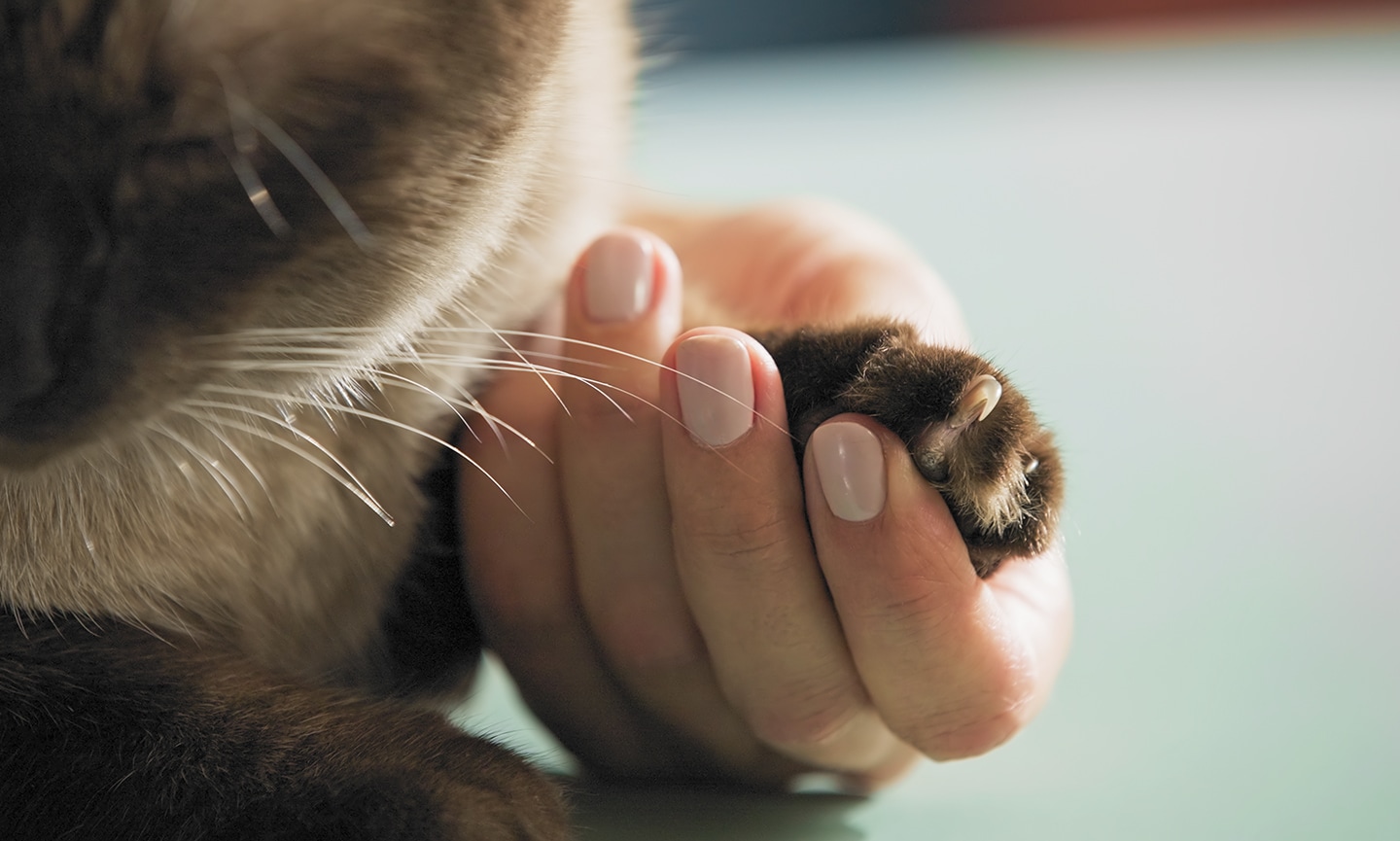
When you’ve found a position that’s comfortable for you and your cat, pick up one of their paws. Do your best to hold the paw in a natural position for your cat, without folding it too far back or forward or bending their leg in an awkward way.
Choose a nail to start with—any of them will do! Because cats have retractable claws, you’ll have to apply slight pressure to the paw pad to extend their nail. Using your non-dominant hand, place your forefinger on your kitty’s paw pad and your thumb on the top of the toe. Squeeze gently to extend the nail, and take note of where the quick is (so that you know where not to cut).
What Is the Quick?
The quick is the pink part of your cat’s nail where blood vessels and nerves are. If you cut it accidentally while trimming the nails, it can cause pain and bleed. But here’s the good news: Since most cats have clear nails, it’s relatively easy to locate and avoid the pink part of the nail. As long as you only trim the white part of the nail, you’re in the clear.
4 Cut at a 45-Degree Angle
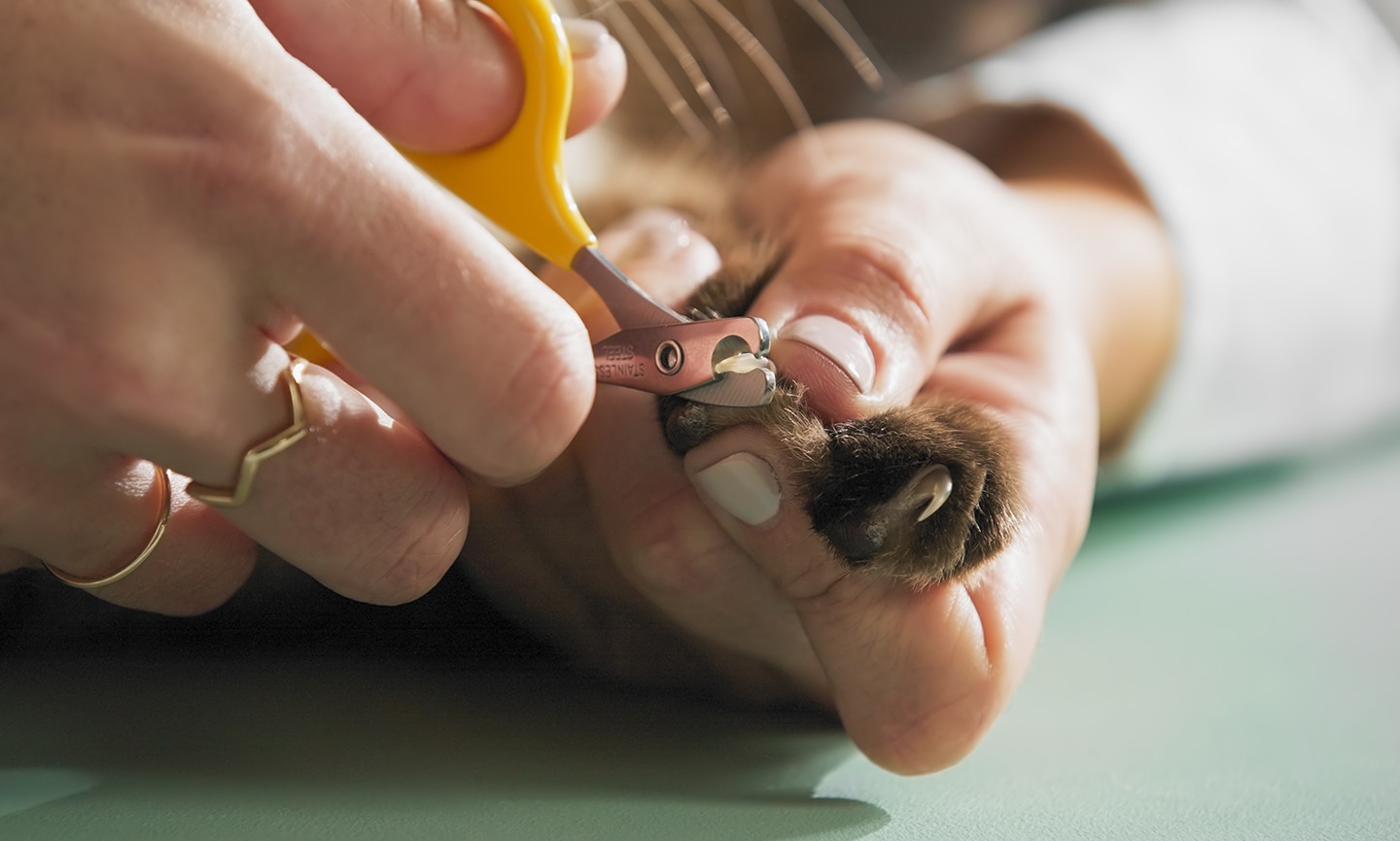
Use your clippers to trim the tip of your cat’s nail. Rather than cutting straight across, aim for a 45-degree angle, which lets the nail rest comfortably on the ground when your cat walks. Use firm, decisive pressure to cut the nail; a softer, more tentative approach can accidentally crush the nail, rather than cut it cleanly.
Pro tip: If your cat has long hair around their paws, make sure it’s pulled back and out of the way so you can see what you’re doing. This is especially important if you choose to use a nail grinder, since that tool can grab hair and pull hard. (Just another reason to try a different tool first.)
5 Take Off a Little at a Time
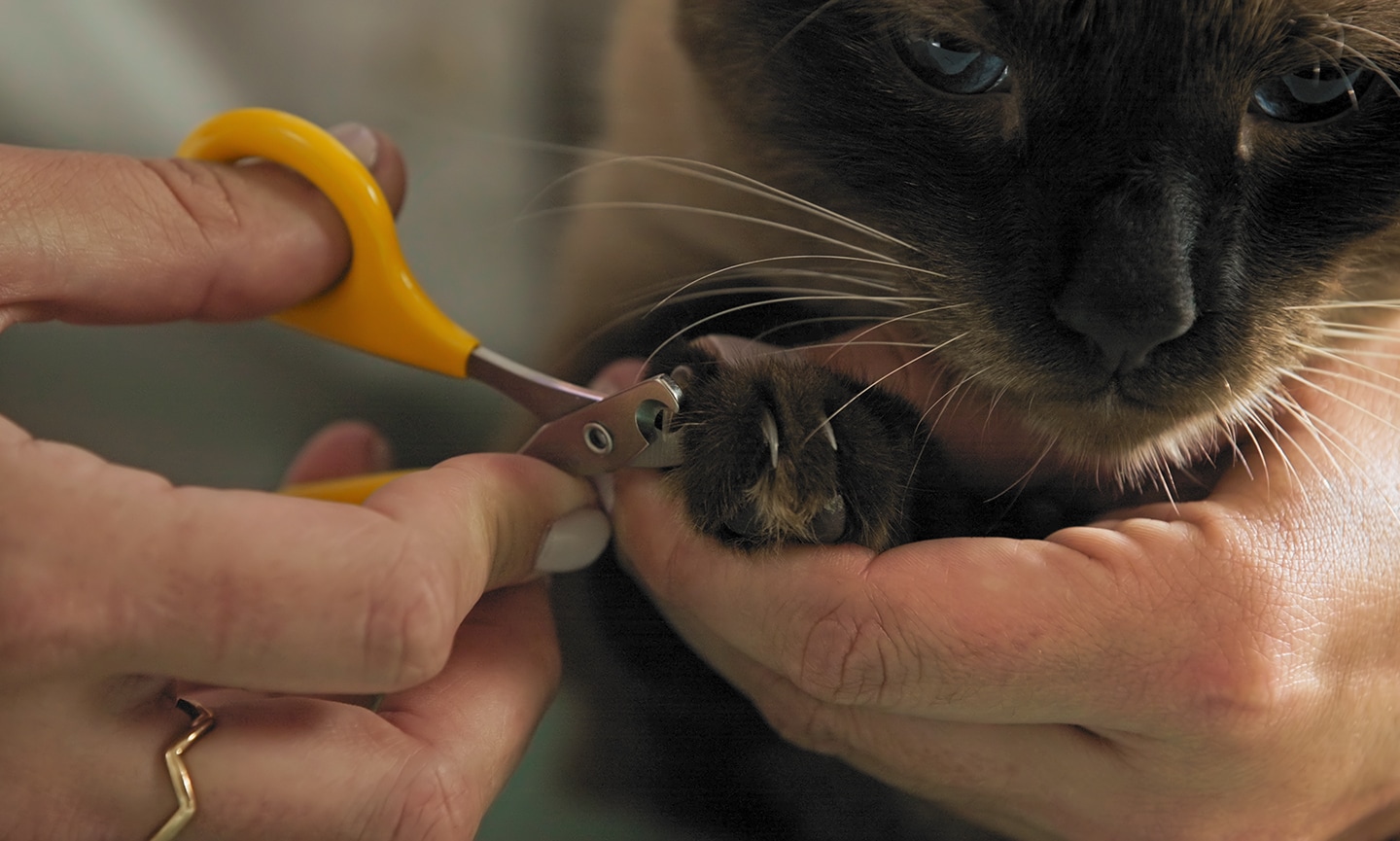
Start by clipping the very tip of your cat’s nail, keeping an eye on the quick to ensure you don’t accidentally hit it. Take off just a little bit at a time, especially if you’re a beginner—it’s better to start slowly and work up to cutting more off in future trimming sessions than to stress your cat out by accidentally cutting the quick.
To help your cat enjoy the experience, you can try giving your cat a treat after every nail. Inaba Churu treats are a hit with many cats! Some cats may refuse treats during nail cutting, though. If your feline doesn’t eat during the trimming, you can save the treats until you’re finished.
While trimming, look for warning signs such as tail twitching, growling, body stiffening or panting. These indicate an angry or stressed cat who may scratch or bite. If you see any of these signs, take a break. Cat bites easily become infected, so always see a doctor if your cat bites you, even if the wound appears minor.
What Happens If I Cut The Quick?
Accidents happen. When you cut the quick, try to stay calm—your cat just might follow your lead and remain calm enough for you to continue trimming. Your cat may be too upset to continue, though, so it’s OK to stop and try again another day.
However, cutting the quick will cause your cat to bleed and experience pain. If you accidentally nick the quick, don’t feel too bad—it happens to the best of us! Sharp tools and your cat’s sudden movements may lead to accidents like quicking a nail.
If you happen to hit the quick, apply a styptic powder, like Miracle Care Kwik-Stop Styptic Powder, to the affected nail and apply pressure for a few seconds. If you don’t have styptic powder on hand, you can use flour or cornstarch, but styptic powder is more helpful for your cat. That’s because flour or cornstarch will only stop the bleeding, while styptic powder stops bleeding while also easing the pain since it contains a topical pain reliever called benzocaine.
6Cut the Rest of Your Cat’s Claws
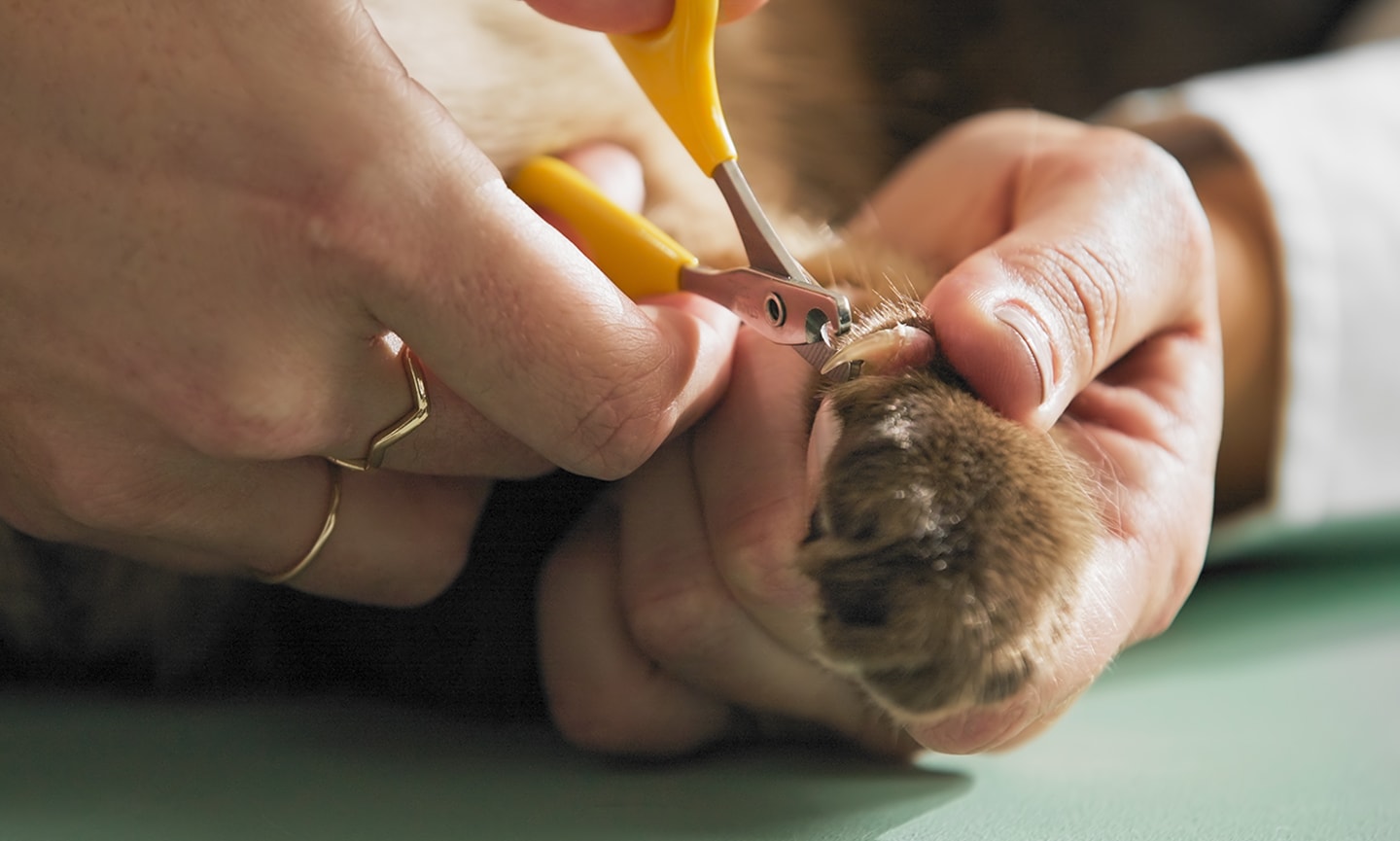
Repeat the above process to trim each of your cat’s nails. Don’t forget the dewclaws! They’re a little higher up your cat’s front paws, like thumbs. If you neglect them, they can grow long enough to curl around and poke into their paw pad—not ideal.
Remember: Some cats have “kitty minutes” and will only choose to participate in this exercise for a few minutes. If your cat gets agitated after you’ve cut a few of their nails, you can always end your session and cut the rest in a day or two. Breaking this task into smaller shifts is totally worth it to keep your cat happy.
7Reward Your Cat
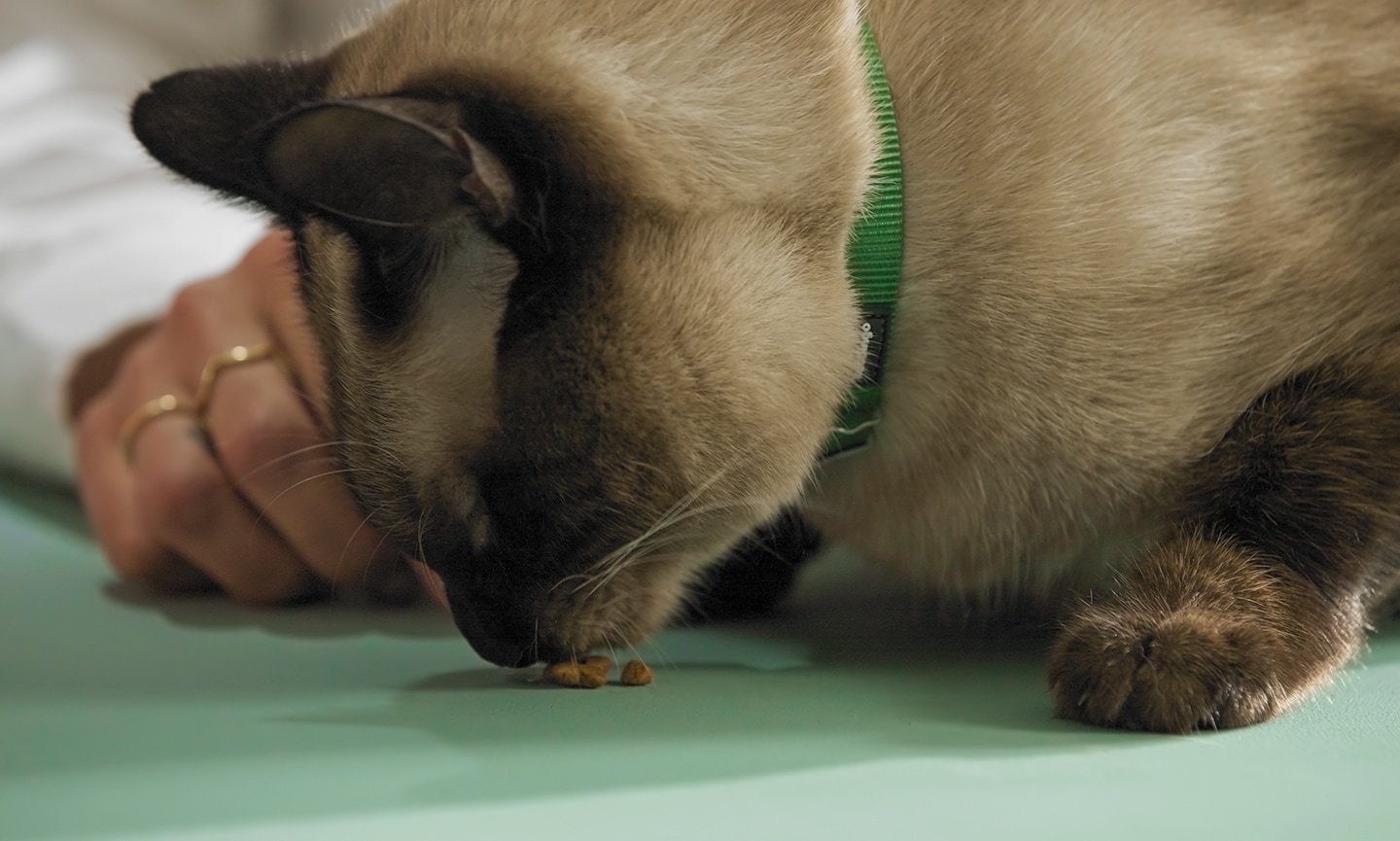
Nail Trimming Tips from the Pros
Practice first: Before you get out the clippers, put your cat in position and practice extending their nails one at a time. When your cat is used to this process, it will help them acclimate when it’s time for the real nail trimming. If you use a nail grinder, you should turn it on during these practice sessions. Don’t actually use it on their nails at first—these practice sessions are just to help your cat get used to the noise.
Stay relaxed: Your cat is masterful at reading your energy. If they sense that you are anxious or worried, they may want no part of the event. Fake it if necessary.
Play soft music: Classical guitar, meditation songs, any type of soothing music can help both you and your cat relax—as long as it does not have bird calls in it.
Use feline pheromones: Stress-relieving pheromones, like Feliway spray, can help your cat chill out when it’s time for a trim.
Use cat treats as a reward: For food-motivated kitties, treats can be a powerful motivator to help put them at ease and make the process enjoyable.
Consider using a padded ironing board instead of your lap: If sitting your cat in your lap is not feasible, a padded ironing board makes an excellent grooming surface. Standing up can give you a better perspective, and it allows a helper to work on one side to help restrain your cat when you’re cutting cat nails.
Use the least amount of force necessary to restrain your cat: Forceful techniques—such as scruffing, in which you hold the cat by the scruff or loose skin of their neck—can result in a rapid escalation of stress for your cat (and related aggression or efforts to escape) and are not recommended. Losing patience will lose the end game and can destroy your cat’s trust in you. Instead, hold your cat in a way that’s both secure and comfortable for them while being protective for you.
Learn to read your cat’s warning signs: Tail twitching, growling, body stiffening and panting are all signs that your cat is becoming upset, and may bite or scratch you. Even purring can be a sign of stress. If you notice any of these, take a break and allow your cat to calm down.
Barbara Bird, an Internationally Certified Master Groomer, award-winning blogger and founding member of the Association of Holistic Pet Professionals, contributed to this story.
This content was medically reviewed by Chewy vets.
More Cat Care Advice
Share:









